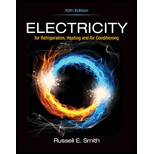
Concept explainers
What is the purpose of a starting relay?
- a. to start an electric motor
- b. to remove the starting winding or component from the circuit
- c. to protect the motor from starting overloads
- d. to prevent the motor from starting under heavy loads
The correct option for the purpose of the starting relay.
Explanation of Solution
The given choices are,
- a) to start an electric motor
- b) to remove the starting winding or component from the circuit
- c) to protect the motor from starting overloads
- d) to prevent the motor from starting under heavy loads
The starting relay is the relay that operates on the principle of back emf. The starting relay is used with a starting winding of single phase motor. This relay control the starting winding, as the single phase motor operates a back emf is produced in the starting winding, this winding acts as the generator that produce back emf which further corresponds to the motor speed. Thus the starting relay is used to drop the starting winding as a predefined back emf is produced in the winding.
Thus, the use of starting relay is to remove the starting winding or component from the circuit.
Thus, the correct option is (b)
Want to see more full solutions like this?
Chapter 9 Solutions
Electricity for Refrigeration, Heating, and Air Conditioning (MindTap Course List)
- What is the procedure to replace the input bellows?(I found this question on the internet and was wondering what the correct answer is out of interest) Remove tubing, old bellows and flapper assembly, install new bellows, connect tubing, install flapper assembly, then calibrate the positioner.Remove tubing, old bellows and cam, install new bellows, connect tubing, install cam, then calibrate the positioner.C. Remove tubing and old bellows, align the quadrant beam, install new bellows and connect tubing, then calibrate the positioner.D. Remove tubing and old bellows, install new bellows and connect tubing, align the quadrant beam, then calibrate the positioner.arrow_forwardGiven the following information: (I found this question on the internet and was wondering what the correct answer is) Firing rate demand = 20% Fuel air ratio = 2:1 Fuel flow = 20% Minimum air flow setting = 5% What is the set point for the air flow controller? 5%B. 10%C. 25%D. 40%arrow_forward. Where is a dew point analyzer installed to measure instrument air?(I found this question on the internet and am wondering what the correct answer is) A. AB. BC. CD. Darrow_forward
- The piston at the bottom of the stroke is 0% open. Which adjustment will change the zero setting to 5% open? ( I found this sample question on the internet and was wondering what the correct answer is out of interest) A.Slide component 2 towards the pivotB. Slide component 2 away from the pivot.C. Increase spring tension using adjustment 1.D. Decrease spring tension using adjustment 1.arrow_forward(read image) (Answer: vA = 4.57 ft/sec)arrow_forward(read image) (answer: αAB = 14.38 rad/s2 CW)arrow_forward
 Refrigeration and Air Conditioning Technology (Mi...Mechanical EngineeringISBN:9781305578296Author:John Tomczyk, Eugene Silberstein, Bill Whitman, Bill JohnsonPublisher:Cengage Learning
Refrigeration and Air Conditioning Technology (Mi...Mechanical EngineeringISBN:9781305578296Author:John Tomczyk, Eugene Silberstein, Bill Whitman, Bill JohnsonPublisher:Cengage Learning Electrical Transformers and Rotating MachinesMechanical EngineeringISBN:9781305494817Author:Stephen L. HermanPublisher:Cengage Learning
Electrical Transformers and Rotating MachinesMechanical EngineeringISBN:9781305494817Author:Stephen L. HermanPublisher:Cengage Learning Understanding Motor ControlsMechanical EngineeringISBN:9781337798686Author:Stephen L. HermanPublisher:Delmar Cengage Learning
Understanding Motor ControlsMechanical EngineeringISBN:9781337798686Author:Stephen L. HermanPublisher:Delmar Cengage Learning Automotive Technology: A Systems Approach (MindTa...Mechanical EngineeringISBN:9781133612315Author:Jack Erjavec, Rob ThompsonPublisher:Cengage Learning
Automotive Technology: A Systems Approach (MindTa...Mechanical EngineeringISBN:9781133612315Author:Jack Erjavec, Rob ThompsonPublisher:Cengage Learning



